 CHRISTIAN SYMBOLOGY
CHRISTIAN SYMBOLOGY
Enjoy the site? Click here to buy the paperback book ($24.99) or PDF book ($9.99)!
© 2001-2025 by Doug Gray. All Rights Reserved.
 CHRISTIAN SYMBOLOGY
CHRISTIAN SYMBOLOGY
Enjoy the site? Click here to buy the paperback book ($24.99) or PDF book ($9.99)!
© 2001-2025 by Doug Gray. All Rights Reserved.
The halo (nimbus) is a universal symbol used by artists and craftsmen to represent a person’s extraordinary holiness. The halo is found in many forms, from a basic thin line to multiple rays beautifully decorated with jewels and flourishes.
The exact origin of the halo is not known, although it has been used throughout antiquity to denote power and greatness. One guess as to its origin has been its connection to the sun. Humans have always been fascinated with the sun, even worshipping it. As sun worship developed, a sun disk was placed behind the head of a certain god/dess to show the god/dess had great power.
Christianity borrowed the sun disk from paganism as early as the fourth century. This is often misinterpreted as Christianity having roots in paganism. This is not true. Every symbol Christianity borrowed from paganism was fully redeemed by having its power and authority connected to God the Father.
At first, the early church only used the halo with the Trinity. When a halo is displayed around a person of the Trinity, it symbolizes divinity. Over time, angels and then disciples, saints, confessors, virgins and martyrs started receiving halos. A disk or plate was used up until the fifteenth century. For the next two centuries, it was reduced to a simple, circular line. After the seventeenth century, the halo ceased to be used altogether. Today, it has limited use.
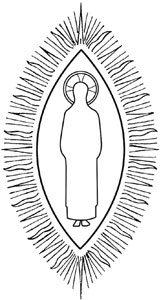
AUREOLE – This is a halo that surrounds the entire body. This halo should be used only with the Trinity and with Mary when she is holding the Christ child. The aureole is usually elliptical in form and has rays or flames of glory radiating from it. Sometimes the aureole hugs the body of the person, making the edges glow.
The aureole is a sign of supreme power, authority and omnipotence. On the rarest of occasions, the aureole will surround the angelic class of thrones, suggesting they receive their power by being in God’s presence.

ELEVATED – The three lines of this halo represent the three parts of the Trinity. This halo is used only with the Trinity.

GREEK HEXAGONAL – This halo is made of two equilateral triangles. It contains the Greek letters Omicron, Omega and Nu. This is an abbreviation of God saying to Moses “I am that I am.” Sometimes the Latin letters “R” “E” “X” are used instead. This halo is used only with God the Father. The letters are always to be arranged as shown.
INSCRIBED – It was a custom at various times in history to add the saint’s name to the halo. This custom started during the 14th century A.D. and lasted for 200 years.

JEWELLED – The jewelled halo suggests royalty, much like a beautifully adorned king’s crown. The jewelled halo is used most frequently with Jesus who is the “King of Kings”. Occasionally, the halo can be used with any member of the Trinity.

LOZENGE SHAPE – This halo takes the shape of a diamond. It should be used only with God the Father.

MONOGRAM – This halo contains monograms of Jesus: the Alpha & Omega and the Chi Rho. Because of such specific references to Jesus, it is to be used with Him only.

NIMBUS A PANS – A halo in the shape of a hexagon, it is used to symbolize an allegorical figure, such as Justice, Faith, Hope, Charity, Prudence and Fortitude.
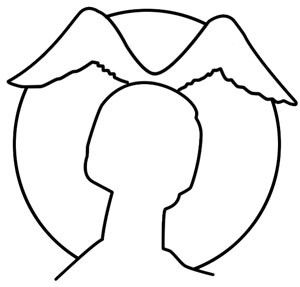
PAGAN – This halo has wings of a bird extending from the top of the head. The halo was borrowed from pagan forms to represent a deity. It is deeply rooted in paganism and should NOT be used to represent the God of the Bible.
PATÉE ADORNED – This halo consists of three rays that curve outward. This halo is to be used only with a member of the Trinity.

IN PERSPECTIVE (Decadent type) – As artistic style became more realistic so did the halo. Artists began to portray the halo with more spatial depth to better match the depth created in their paintings. The halo in perspective is often just a single gold line and is usually more elliptical to create the illusion of perspective.

RAYED – This halo consists of three sets of three rays enclosed or breaking through a circle. A variant of the tri-radiant halo, it is used only with a member of the Trinity.
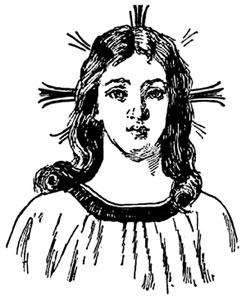
RAYED (SIMPLE) – This halo substitutes a circular halo with nine rays of light. The rays are placed in groups of three as a sign of the Trinity. It is used only with a member of the Trinity.
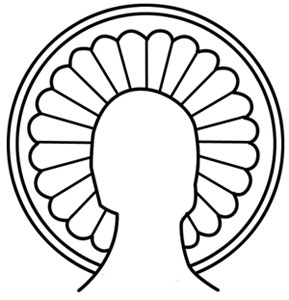
SCALLOPED – This decorative halo has various rays that radiate outward. The rays end in curves, forming a sort of shell-like appearance.
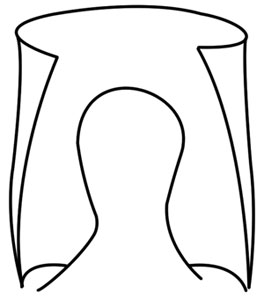
SCROLL – A variation of the square and rectangular halos.

SQUARE – A square halo symbolizes a person who was alive when the likeness was made. The square halo was not instituted until the 9th century A.D. and was looked upon as a lesser halo than the circle. The square symbolizes earth while the circle symbolizes Heaven. The square halo is unique to Italian art.
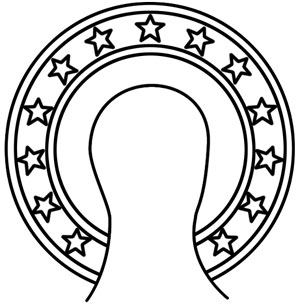
STARRY – A halo with a row of stars symbolizes the Virgin Mary. It is to be used with no other person or deity.

TRI-RADIANT – This halo consists of three bars contained in a circle. It is to be used to represent only a member of the Trinity, usually Jesus.

TRIANGULAR (Equilateral) – This halo was developed intentionally to separate the Father from the Son and Holy Spirit. It is used only to represent a person of the Trinity, typically God the Father. The triangular halo was not instituted until the 11th century A.D. After the 16th century A.D., the image of God the Father ceased being used. Instead, His name in Hebrew (YHWH) is found inside the triangle.
FOOTNOTES
-